January 03, 2011
By G&A Staff
SIG's new trigger system is allowing the company to mount a major challenge to other pistol companies that have been dominant in the U.S. police and military markets.
By Dick Metcalf
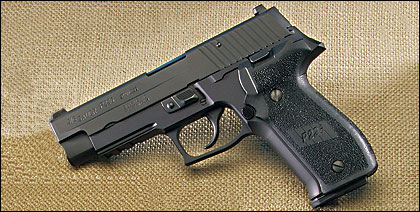 SIG Model P226R DAK |
SIGARMS (Dept. ST, 18 Industrial Dr., Exeter, NH 03833; 603-772-2302; www.sigarms.com) is having a very good year. It started last June when the Rhode Island state police completed its transition to the SIG P226R in .357 SIG as its standard duty firearm and reported that since November 2003 approximately 100,000 rounds had been fired through 200 duty pistols with no mechanical failures.
This was important because Rhode Island was the first agency in the country to adopt the new SIG DAKtm trigger system--a double action only (DAO) mechanism designed to provide a safe and reliable 6.5-pound trigger pull, which is much lighter than conventional DAO triggers. It was also important because it meant that four out of six New England state police forces are now carrying SIG pistols (the others are Vermont, Massachusetts, and Connecticut), joining other such major SIG-equipped state police departments as New Jersey, Virginia, and the Texas Rangers.
Advertisement
Then in August 2004, the U.S. Department of Homeland Security (DHS) Office of Immigration and Customs Enforcement (ICE) awarded SIG a five-year contract for up to 65,000 9mm and .40 S&W pistols. The contract is for full-size P226R and mid-size P229R rail pistols with the DAK trigger system and 12-round magazine capacity and the compact P239 seven-round single-stack with conventional DAO.
The selection process included pistols manufactured by several companies and involved the most extensive governmental testing and evaluation process since the historic military trials of the 1980s that resulted in the replacement of the Model 1911 .45 by the Beretta 9mm as the U.S. Armed Forces standard sidearm. The recent tests were in fact much more advanced and sophisticated than those earlier tests. Throughout the entire DHS testing the SIG pistols earned the highest scores possible.
Advertisement
| SPECIFICATIONS - P226R DAK | 

Manufacturer: SIGARMS
Model: P226R DAK
Operation: Recoil-operated autoloader
Caliber: .40 S&W
Barrel length: 4.4 in.
Overall length: 7.7 in.
Weight, empty: 34 oz. Safety: Firing pin lock, decocking lever, safety intercept notch, trigger bar disconnector
Sights: 3-dot tritium night sights
Stocks: Wraparound textured rubber
Magazine capacity: 12 rounds
Finish: Black stainless steel
Price: $915
|
|
Following on the heels of the DHS announcement, the U.S. Coast Guard awarded a contract to SIGARMS for the P229R DAK in .40 S&W, basing its decision on the performance of the SIG guns in the DHS tests. The Coast Guard pistols are in addition to those ordered for the DHS Office of Immigration and Customs Enforcement. The Coast Guard will be replacing its current Beretta 9mm pistols with the SIGs.
And if that wasn't enough, on December 22, 2004, the U.S. Army Tank-automotive and Armaments Command at the Rock Island Arsenal awarded SIGARMS a contract for 5000 9mm SP2022 pistols. The SP2022 is a polymer-framed SIG featuring an M1913 Picatinny rail with a stainless-steel slide and cold hammer-forged barrel.
That's three major federal law-enforcement and military contracts for SIGARMS in less than four months, in the midst of ongoing sales to a growing list of state police agencies and major municipal departments.
I think it's fair to say that SIG is on a roll and is mounting a major challenge to other pistol companies that have been dominant in the U.S. police and military markets in recent decades. Up until now, SIG pistols primarily have been the choice of elite-unit federal agencies that can afford the more premium-level prices that SIG commands. The introduction of the new DAK trigger system for the P226 and P229 models seems to be changing that, and SIG is preparing for increased demand.
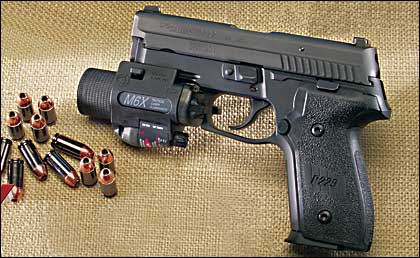 SIG Model P229R DAK |
In 2003 it expanded operations at its Exeter, New Hampshire, facility with the addition of several new state-of-the-art CNC machines, increasing production capacity by over 25 percent. And in 2004 SIGARMS received certification as an ISO 9001: 2000 company.
| SPECIFICATIONS - SIG P229R DAK | 

Manufacturer: SIGARMS
Model: P229R DAK
Operation: Recoil-operated autoloader
Caliber: .40 S&W
Barrel length: 3.8 in.
Overall length: 7.1 in.
Weight, empty: 32.4 oz. Safety: Firing pin lock, decocking lever, safety intercept notch, trigger bar disconnector
Sights: 3-dot tritium night sights
Stocks: Wraparound textured rubber
Magazine capacity: 12 rounds
Finish: Black stainless steel
Price: $915
|
|
The DAK Advantage
So what is this DAK thing? And why are people making such a big deal about it? In bare-bones description, the DAK mechanism provides a hammer-fired full-length double-action trigger pull, with comp
lete repeat-strike capability, that is notably lighter than other full-length DAO pull mechanisms. Here's why this is important.
There are three factors at work in deciding what type, and "feel," of trigger action an agency (or an individual) wants once they have made the increasingly prevalent basic decision to use a DAO (i.e., noncockable) pistol instead of a conventional double-action design. One is length of trigger pull. Another is weight of trigger pull. And the third is whether or not you can re-pull the trigger in the event of a misfire without needing to manually cycle the slide. Assuming equal reliability/durability/accuracy among prospective designs, how those three factors are weighed and ranked in importance will determine what particular pistol's action a prospective purchaser/user will like best. Among well-known brands of DAO mechanisms the choices are extensive and confusing.
For example, the ubiquitous "safe action" Glock and the similar S&W Sigma are striker-fired and have very short trigger pulls (with an imbedded safety) that are lighter than the DAK trigger pull, but in the event of a misfire these designs require a manual rearward movement of the slide to "preload" the striker-fired mechanism before the trigger can be pulled again. Other DAO examples like the original S&W Third Generation auto pistols were hammer fired and had full-length trigger pulls in the 9- to 11-pound range but also required a manual rearward motion of the slide to partially cock the hammer and reset the trigger mechanism following a misfire (or dry-fire). Other designs like Taurus's compact Millennium and full-size 24/7 models are striker-fired, have an 8- to 10-pound full-stroke trigger pull, and have complete repeat-strike capability. In the event of a misfire, you can keep on pulling the trigger until the round goes bang or you decide to manually clear the action and try a fresh one.
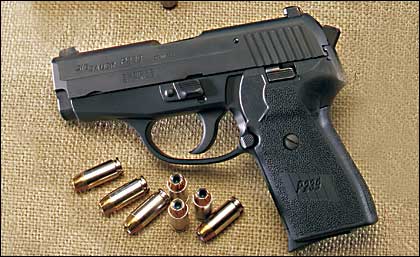 SIG Model P239 DAO |
The initial point of choice for most purchasers seems to be repeat-strike capability. Many duty/defense pistol users believe it is ludicrous to carry a gun for life-protection if it requires two hands to operate should the trigger need to be pulled a second time in the event of a misfire. (What if the other hand is injured or otherwise engaged with the threat?) Such users also observe that it is a demonstrated fact that fully 80 percent of misfires do indeed fire on the second strike because the first hit served to solve whatever the problem was (a little crud in the firing pin channel, a not fully seated round, etc.).
A misfire in a crisis situation is already a disaster. Why deny yourself an 80-percent chance of solving the problem by a simple second pull of the trigger by requiring you to jack the slide with your other hand and chamber a completely different round? People who think this way will never be happy with a Glock (or similar mechanism), no matter how short and light the trigger pull.
That's one point of view. On the other hand, many pistol trainers believe strongly that proper training in "tap-rack-bang" drills will instill a reflex that is every bit as effective as an instinctive repeat strike (and also will eliminate the problem of the 20 percent of misfires that do not go bang the second hit). Such people are much more likely to value the shorter and lighter aspects of a Glock-type trigger over the longer and heavier pulls of conventional DAO mechanisms--repeat strike or not.
The SIG DAK design is appealing because it provides a mechanism that allows many of these counterpoint perspectives to meet in the middle. Developed by the engineers at Sauer in Germany, the new DAK trigger system delivers a smooth, consistent 6.5-pound full-length trigger pull that is much closer to the weight of a Glock than any conventional DAO but also has complete restrike capability without any pretensioning or prestressing of the internal firing mechanism.
There is nothing magical about the design; everything is accomplished by simple mechanical advantages in the trigger/hammer linkages. The key is that the engineers were able to extend the "leverage arm" of the hammer from the pivot point (like sitting farther from the fulcrum of a seesaw) so that less force is required from the trigger while remaining within the existing dimensions of the P226 and P229 frames.
| SPECIFICATIONS - P239 DAO | 

Manufacturer: SIGARMS
Model: P239 DAO
Operation: Recoil-operated autoloader
Caliber: .40 S&W
Barrel length: 3.6 in.
Overall length: 6.6 in.
Weight, empty: 29.8 oz. Safety: Firing pin lock, decocking lever, safety intercept notch, trigger bar disconnector
Sights: 3-dot tritium night sights
Stocks: Wraparound textured rubber
Magazine capacity: 7 rounds
Finish: Black stainless steel
Price: $779
|
|
After initial firing, the shooter can control the trigger reset either to an intermediate point with a shorter pull distance and two-pound heavier weight (the trigger bar intersects the hammer arm closer to the pivot point) or fully reset to the original longer and lighter weight position.
Externally, the only visible difference between a SIG DAK mechanism and a conventional SIG DAO mechanism is that the DAK trigger has a slightly slimmer profile and the DAK hammer sits completely within the frame when at rest, while the DAO hammer protrudes slightly. Other attractive features include the fact that the slide must be locked back and the magazine removed to disassemble, and it can be disassembled without having to pull the trigger.
When these features are combined with the fact that the SIG P226R DAK and P229R DAK pistols came out at the unchallenged top for every facet of the most rigorous and extensive set of U.S government handgun tests ever applied, well, no wonder that SIG's fortunes in the duty-pistol marketplace are taking a remarkable turn for the better.
Rigorous Government Tests
Did I say rigorous? When I read the test standards used for the DHS contract, I was amazed. In addition to all the familiar drop tests, accuracy tests, and durability tests that have long been standard parts of law-enforcement and military procurement procedures, the raw stress and abuse the government today expects modern duty pistols to endure is, well, beyond extreme. Here are just a cou
ple of excerpts from the Department of Homeland Security's Performance Description for a Service Pistol Procurement.
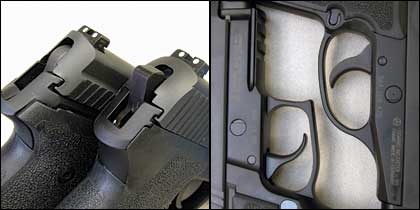 The DAK hammer sits below the surface of the slide when at rest while the hammer of conventional DAO mechanisms protrudes above the surface of slide. The new DAK trigger is not as thick as that of a conventional SIG DAO pistol. |
Plugged Barrel Test: "An appropriate caliber bullet for the chambered caliber will be pressed into barrel from the breech to a depth of 1.16 inches as measured from the breech. The barrel will be re-installed and the pistol fired using one round of service ammunition. Any barrel deformation or damage will be noted. The test will be repeated, with a second pistol, with a bullet lodged 0.5 inch from the end of the muzzle. Any barrel deformation or damage will be noted."
Sand and Dust Test: "Five (5) fully loaded holstered pistols will be placed in a 43 inch x 21 inch x 25 inch wooden dust test chamber, with the barrel vertical and muzzle down. A 1/10 horsepower motor driving a 500 cubic feet per minute squire cage blower attached to one end of the test chamber will be used to disperse two pounds of Quickrete Play Sand.
The sand will be sifted through an 18 x 14 threads screen to remove the larger particulate. The sand will be gravity fed into the blower intake at a rate not to exceed two (2) pounds per minute, and will be allowed to run for three (3) minutes totaling six (6) pounds of sand. After three (3) minutes, the chamber will be opened and the pistols removed from the holsters. Any loose dust will be shaken from the pistols. The pistol will then be fired. Any malfunctions will be noted."
Salt Water Immersion Test: "Five (5) fully loaded pistols with one (1) extra, fully loaded magazine per pistol will be submerged in a salt-water solution of 5% sodium chloride and 95% distilled water by weight for sixty (60) seconds. The pistols will be removed and held muzzle down to drain the bore and then placed in a climatic chamber at 70F and 70% RH for 24 hours. The fully loaded pistols shall then be fired, re-loaded with the extra magazine and fired again. Results will be noted."
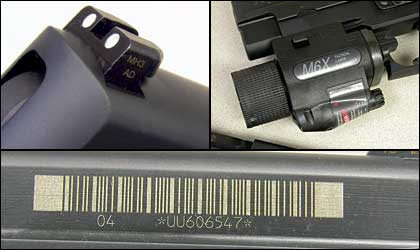 SIG's Homeland Security pistols feature three-dot tritium night sights, and the P226R and P229R models come with integral accessory rails. All SIG pistols now come with a laser-imprinted serial number barcode. |
Temperature Tests: "Five (5) fully loaded pistols with one (1) extra loaded magazine per pistol will be placed in a climatic chamber, at 200F for eight (8) hours. Each pistol and extra magazine will be removed from the climatic chamber and all fired within one (1) minute. Results will be noted. Five (5) fully loaded pistols with one (1) extra, fully loaded magazine per pistol will be placed in a climatic chamber and conditioned to minus 30F for eight (8) hours. Each pistol and extra magazine will be removed from the climatic chamber and fired within one (1) minute. Results will be noted."
 All three pistols easily beat the defensive accuarcy standard of 4.25 inches at 25 yards. |
Okay, you tell me. Would you expect any handgun you currently own to function under these conditions? The SIG pistols did.
The New DHS Guns On The Firing Range
SIGARMS provided Shooting Times with review samples of each of the three .40 S&W pistol models that are being purchased under the DHS/ICE contract: a 4.4-inch-barreled P226R DAK with 12-round magazine, a 3.8-inch-barreled P229R DAK with 12-round magazine, and a 3.6-inch-barreled P239 DAO with single-stack seven-round magazine. I collected a sample of five different commercial .40 S&W ammunition loads in bullet weights and configurations particularly applicable for law-enforcement and personal-defense use and subjected each gun to a ballistic and performance review at 25 yards. The results are listed in the accompanying chart.
In view of SIG's well-known premium quality, no one should be surprised by the fact that all three pistols delivered average group sizes with all reviewed ammunition loads that are considerably better than the norm for duty-grade auto pistols.
| SHOOTING SIG's .40 S&W DHS PISTOLS |
|---|
| Factory Load | Muzzle Velocity (fps) | Standard Deviation (fps) | 25-Yard Accuracy (inches) |
|---|
| P226 DAK 4.4-inch Barrel |
|---|
| Hornady 155-gr. TAP FPD | 1187 | 14 | 2.56 |
|---|
| Remington 165-gr. Golden Saber | 1130 | 11 | 2.75 |
|---|
| Federal 180-gr. JHP/HST | 985 | 9 | 2.68 |
|---|
| Hornady 180-gr. XTP/HP | 992 | 5 | 2.50 |
|---|
| Winchester 180-gr. SXT | 1003 | 9 | 2.25 |
|---|
| P229 DAK, 3.8-Inch Barrel |
|---|
| Hornady 155-gr. TAP FPD | 1146 | 3 | 2.83 |
|---|
| Remington 165-gr. Golden Saber | 1074 | 9 | 2.68 |
|---|
| Federal 180-gr. JHP/HST | 953 | 16 | 2.88 |
|---|
| Hornady 180-gr. XTP/HP | 967 | 17 | 2.75 |
|---|
| Winchester 180-gr. SXT | 971 | 14 | 2.50 |
|---|
| P239 DAO 3.6-inch Barrel |
|---|
Hornady 155-gr. TAP FPD | 1129 | 10 | 2.88 | | Remington 165-gr. Golden Saber | 1086 | 13 | 3.13 |
|---|
| Federal 180-gr. JHP/HST | 971 | 8 | 3.00 |
|---|
| Hornady 180-gr. XTP/HP | 953 | 12 | 3.00 |
|---|
| Winchester 180-gr. SXT | 966 | 7 | 2.83 |
|---|
| NOTES: Accuracy is the average of three full-magazine groups fired from a sandbag benchrest at 25 yards. Velocity is the average for one full magazine measured 10 feet from the guns muzzles |
Nor was I at all surprised that there were exactly zero stoppages or malfunctions with any of the three pistols throughout the entire firing session--which put somewhat more than 300 rounds through each gun. I was happy to have the opportunity to fire the P226 and P229 DAK models side by side with the conventional DAO P239. The improvement in weight and smoothness of the DAK mechanism is striking, and the hand-fitting design of the P226 and P229 grips make for extremely comfortable and natural-point shooting.
The DAK trigger mechanism is currently available only in the P226 and P229 models, both of which are listed in the SIG catalog as available for commercial sale. SIGARMS fans are already clamoring for the DAK system to be incorporated throughout the SIG model lineup, and SIG has stated that a DAK version of the P239 is on the way. Within the constraints of frame size and mechanical feasibility, further expansion is inevitable. It's just too good a product.
